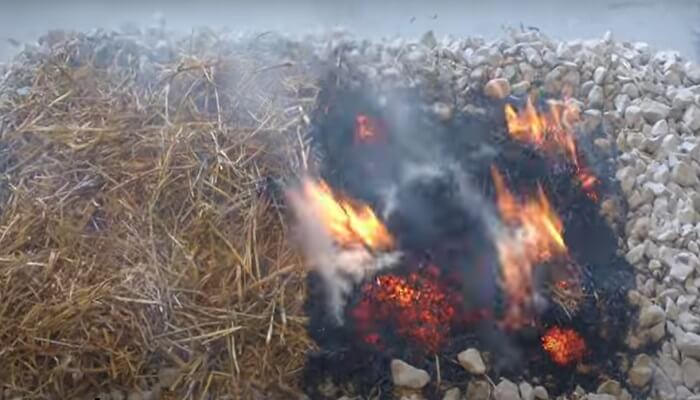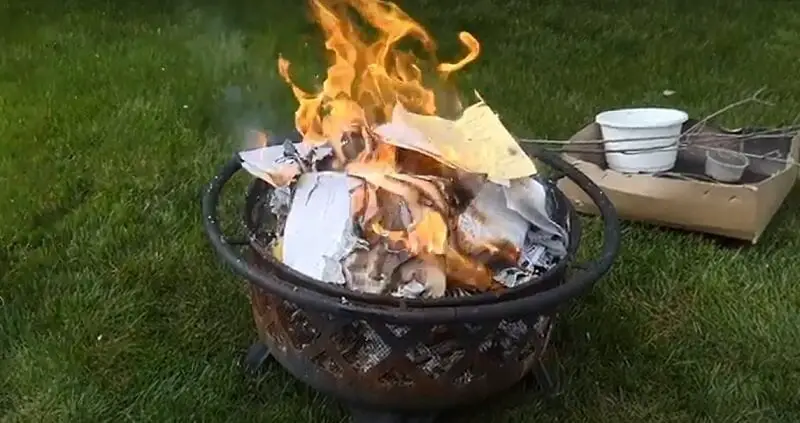Is It Safe to Burn Straw/Paper in a Fireplace? What Should Be Burned?
Note: This article may contain affiliate links, which means if you make a purchase following our links won’t cost you extra, but we may earn a commission. Learn more
Straw is a common material used in agricultural and construction settings, so it stands to reason that you might be able to burn it in your fireplace. However, there are some potential risks associated with burning straws that you should be aware of before you try it.
When straw burns, it produces a lot of smoke and ashes. This can be a fire hazard, as the ashes can easily ignite other materials. Smoke from straw fires can also be a health hazard. Straw smoke can contain harmful chemicals, including carbon monoxide and particulate matter.
Particulate matter is a type of air pollution that can be harmful to your health. It is made up of tiny particles that can get into your lungs and cause respiratory problems. Carbon monoxide is a poisonous gas that can cause symptoms such as headaches, dizziness, and nausea.
Straw is highly combustible and produces a lot of smoke when it burns, so if you have no alternative you have to take all the necessary steps before lighting the fire.

Why You Shouldn’t Burn Straw in Your Fireplace or Fire Pit?
When it comes to burning straws in your fireplace or fire pit, you should really think twice before doing so. While it may seem like a good idea at first, it can actually be quite dangerous and cause a lot of problems. Here are just a few reasons why you shouldn’t burn straw in your fireplace:
It can create a lot of smoke. If you burn straw in your fireplace, it can create a lot of smoke. This smoke can be very irritating and can even cause respiratory problems. It’s best to avoid it if possible.
It can cause a fire: If you have a lot of straw in your fireplace, it can actually catch on fire quite easily. This is especially true if you have any embers or flames that are still burning. If the straw catches on fire, it can quickly spread to the rest of your house and cause a lot of damage.
It’s not good for your chimney: When you burn straw in your fireplace, it can actually clog up your chimney. This is because the straw can break down and create a lot of ash. This ash can then get caught in your chimney and cause problems. It’s best to avoid this by not burning straw in your fireplace.
It’s not good for the environment: When you burn straw in your fireplace, it releases a lot of harmful chemicals into the air. These chemicals can be damaging to the environment and can even cause health problems for people who breathe them in.
It’s not necessary: There are plenty of other things that you can burn in your fireplace that are much better than straw. Wood is a much better option and it’s actually good for your fireplace. It’s also much better for the environment.
So, if you’re thinking about burning straw in your fireplace, you should really think twice. It’s not worth the risk and it’s not necessary. There are plenty of other things that you can burn that are much safer and better for your fireplace.
What You Should Burn in Your Fireplace or Fire Pit?
1. Untreated Wood/ Seasoned Wood
Untreated hardwoods like oak, ash, or maple are ideal for burning in fireplaces and fire pits. These woods burn hot, and slow, and produce less smoke.
Seasoned wood, which is wood that has been dried for at least six months, is a top choice. It burns cleaner and produces more heat than green, or unseasoned, wood.
2. Manufactured Logs/ Eco Logs
Manufactured logs, made from wax and sawdust, are a convenient option. They burn clean and are easy to handle.
Eco logs, made from compressed sawdust, are an environmentally friendly option. They burn hot and produce less ash than traditional wood logs.
3. Paper and Cardboard/ Newspaper Knots
Small amounts of paper or cardboard can be used to start a fire. It’s best to avoid glossy or colored paper, as it can release harmful chemicals.
Twisted or knotted newspapers can be a good fire starter. It burns quickly and helps ignite larger pieces of wood.
4. Natural Fire Starters/ Pine Cone Fire Starters
Materials like pine cones, dried orange peels, or twigs can be used to start a fire. They are natural and readily available.
Pine cones, especially when dipped in wax, make excellent fire starters. They burn hot and help ignite larger pieces of wood.
5. Bamboo/ Bamboo Charcoal
Bamboo can be burned in a fire pit or fireplace. It burns hot and fast, and it crackles pleasantly. Bamboo charcoal is a great option for a smokeless fire. It burns at high temperatures and produces less ash than wood.
6. Smokeless Fuel/ Smokeless Coal
Smokeless fuel is a good option for those who want a clean, smoke-free fire. It’s made from coal and is suitable for fire pits and fireplaces.
Smokeless coal is a type of smokeless fuel that burns hot and long. It’s ideal for those who want a fire without the smoke.
What Should You Never Burn in Your Fireplace or Fire Pit?
Most people are aware that they shouldn’t burn trash or treated wood in their fireplace or fire pit, but there are other items you should avoid burning as well. Here is a list of things you should never burn in your fireplace:
1. Plastic
Even if it’s just a few stray wrappers from your kids’ candy, burning plastic produces harmful chemicals like dioxins and furans. These chemicals can cause respiratory problems and cancer.
2. Styrofoam
Like plastic, styrofoam also releases harmful chemicals when burned. In addition, it doesn’t burn completely and can leave behind large pieces that can clog your chimney.
3. Paper bags
While paper bags will eventually burn up, they release a lot of smoke and can quickly start a fire if not monitored carefully. It’s best to avoid them altogether.
4. Wet wood
Wood needs to be properly seasoned before burning to ensure that it burns evenly and doesn’t produce too much smoke. If you try to burn wet wood, it will produce a lot of smoke and could damage your chimney over time.
5. Green Wood
Green wood is wood that hasn’t had a chance to cure yet. It’s still full of water, which makes it difficult to light and causes it to produce a lot of smoke.
6. Soft Wood
Soft woods like pine and cedar are also not good choices for firewood. They don’t produce a lot of heat and they tend to produce a lot of sparks.
7. Treated Wood
Treated wood is wood that’s been treated with chemicals, like pressure-treated lumber. These chemicals can be released into the air when the wood is burned, which can be dangerous to your health.
8. Painted Wood
Painted wood is another type of wood that you should never burn in your fireplace. The paint can release harmful chemicals into the air when it’s burned.
Read More: 6 Best Fire Pit For Grilling In 2022
Is It Safe to Burn Paper in a Fire Pit or The Fireplace?
You may be surprised to learn that it’s not safe to burn paper in a fire pit or fireplace. While the occasional piece of paper may not cause any damage, burning paper in a fire pit on a regular basis can be dangerous. Here’s why you should avoid burning paper in your fire pit:
The paper produces toxic chemicals when burned. When paper burns, it releases a number of toxic chemicals into the air. These chemicals can be harmful to your health if inhaled, and they can also pollute the air around your home.
Paper can cause your fire pit to spark. Paper is highly flammable, which means it can easily cause your fire pit to spark. These sparks can then land on nearby combustible materials and start a fire.
Paper can clog your fire pit. If you burn a lot of paper in your fire pit, it can eventually start to clog the opening. This can make it difficult to get a good fire going, and it can also be dangerous if the clog causes the fire to build up too much pressure and eventually explode.
Paper can make your fire smoke. Smoke from a fire pit can be annoying and potentially harmful to your health. If you add paper to the fire, it will produce even more smoke.

Paper can reduce the oxygen supply to your fire. Paper burning in a fire pit can consume a lot of oxygen, which can then starve the fire and cause it to go out.
If you want to enjoy a safe and healthy fire pit experience, avoid burning paper in your fire pit. There are plenty of other things you can burn, such as wood, that will provide you with the same experience without the risks.
Summary
Burning in a fireplace or fire pit is generally safe, provided the right materials are used. Pressure-treated wood, for instance, should not be burned. This wood contains chemicals that, when ignited, release harmful fumes. Cardboard, on the other hand, can be safely burned, but it tends to produce more smoke and ash. Bamboo is another material that can be safely burned, and it produces a pleasant aroma.
For a smokeless fire pit experience, consider using specially designed smokeless fuel. This can be a great alternative to wood. Particle boards and pressed wood, similar to pressure-treated wood, are not recommended for burning due to the release of harmful chemicals.
Paper is safe to burn in a fire pit, but it should be done in moderation as it can quickly lead to an out-of-control fire. Cardboard can also be burned in a fire pit, but it should be broken down into smaller pieces first to ensure a controlled burn.
Burning cardboard boxes outside is generally safe, but it’s crucial to monitor the fire at all times. For a unique fire pit experience, consider burning materials that repel mosquitoes, such as citronella or sage.